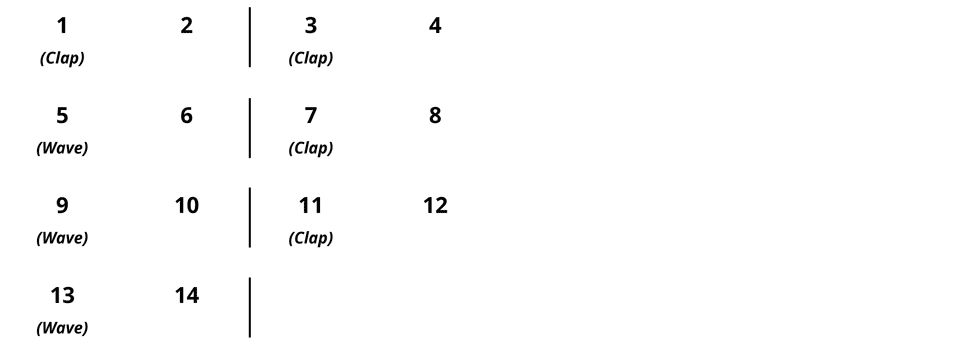Āṛāchārtāl – आड़ाचारताल
Also known as āṛāchautāl – आड़ाचैताल
- Beats: 14
- Divisions: 7 (stressed = 4, unstressed = 3)
- Structure: 2–2–2–2–2–2–2 (X–2–0–3–0–4–0)

Introduction to Arachartal
Arachartal (or arachautal) is a well known tal in the northern tradition. However, it is less common than the other major tals given in this Tals and Thekas section, though it may be more common in some lineages than others.
You may not have many chances to play in arachartal, or to hear many performances in arachartal. But arachartal is a helpful tal to practice for reasons I discuss below. Also, Chhotelal Misra included arachartal compositions in his publications, and so I have chosen to include them here.
Although I never asked Chhotelal about why he chose to include arachartal compositions in his books, it may have been because arachartal compositions offer another way to practice the popular division of 7.
Arachartal Structure
Arachartal has a structure of 7 vibhags of 2 matras each, with a tali-khali pattern of tali-tali-khali-tali-khali-tali-khali (stressed-stressed-unstressed-stressed-unstressed-stressed-unstressed):

In written form, arachartal vibhags are commonly marked X–2–0–3–0–4–0:
- X = sam and first tali vibhag
- 2 = second tali vibhag
- 0 = khali vibhag
- 3 = third tali vibhag
- 0 = khali vibhag
- 4 = fourth tali vibhag
- 0 = khali vibhag

There may be other ways to divide and mark arachartal, depending on the lineage. Sadanand Naimpalli, for example, offers a division of 2–2–2–2–3–3 with a tali-khali pattern X–0–2–0–3–4.
Arachartal Timekeeping Pattern
The arachartal vibhags are shown by the timekeeping pattern of clap-clap-wave-clap-wave-clap-wave:

Arachartal Timekeeping with Lahra
The video below shows the arachartal timekeeping pattern with lahra (melodic timekeeping).
Compositions in Arachartal Versus Compositions in Rupak Tal
Although arachartal is a cycle of 14, theme-and-variation compositions (kayda, rela, etc.) in arachartal are usually made of two phrases of 7 matras. And those 7 matras are typically divided as 4–3 (those on this website, at least). The rupak compositions on this site, however, are typically divided 3–4.
Below are two kayda themes, the first in rupak and the second in arachartal. The main phrases are grouped in parenthesis:
Rupak Phrases grouped in 3–4:

(from Rupak Tal – Benares Kayda 3)
Arachartal Phrases Grouped in 4–3:

(from Arachartal – Benares Kayda 1)
Because rupak tal is so popular, it is important to learn how to improvise in divisions of 7 (or 14). Arachartal compositions give us another way to practice phrases of 7.
However, not all phrase divisions in rupak and arachartal compositions follow these divisions. I have seen rupak compositions with phrases in 4–3, and arachartal compositions with phrases in 3–4 (and other divisions).
And when improvising, many tabla players do not always follow these divisions for either tal. They will regularly mix a variety of divisions for both rupak and arachartal, sometimes in the same way for both tals.
But for practice, Chhotelal emphasized consistent practice with the most common divisions of 7 and 14, which are 3–4 and 4–3; rupak gives us practice in 3–4, and arachartal gives us practice in 4–3.
And this is valuable not only for playing in tals of 7 and 14, but also in other tals including tintal, where we often need to create phrases of 3 and 4.
References
Misra, Chhote Lal. Tal Prabandh. New Delhi: Kanishka Publishers, 2006. (Hindi)
Naimpalli, Sadanand. Tabla for Advanced Students. Mumbai: Popular Prakashan Pvt. Ltd., 2009.